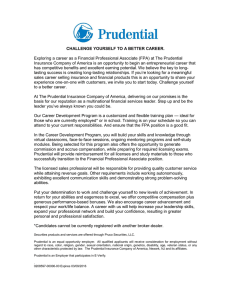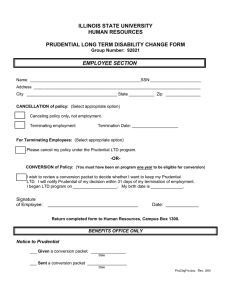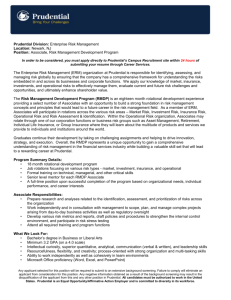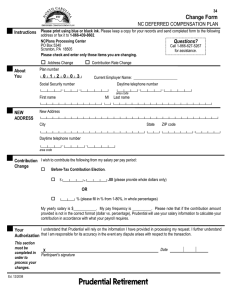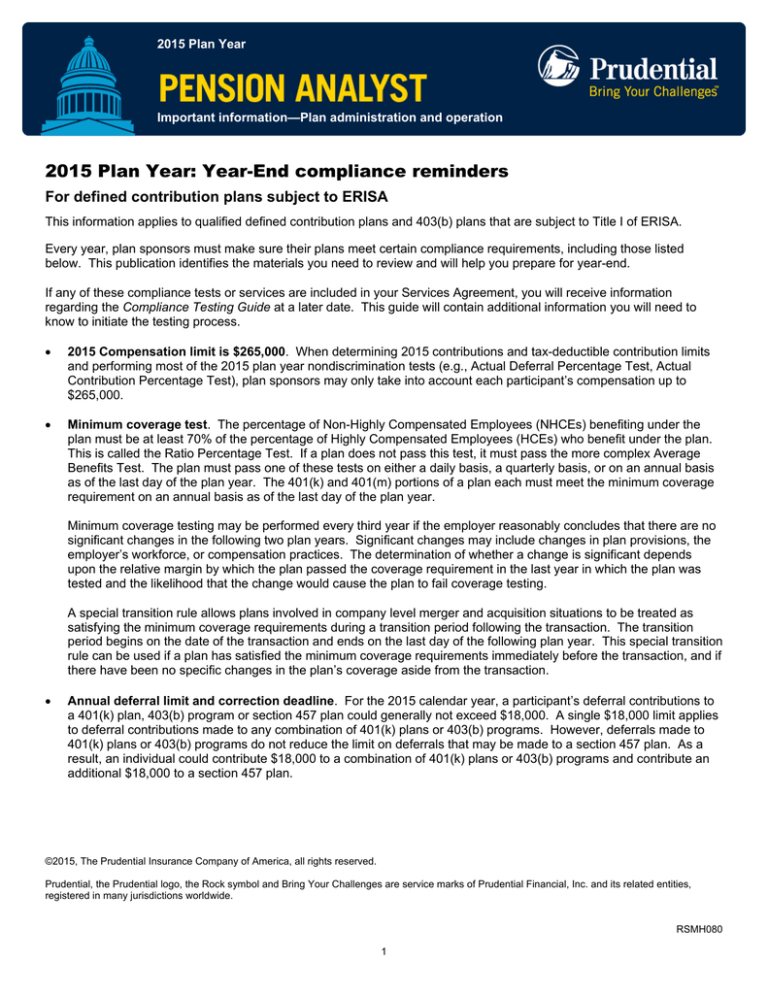
2015 Plan Year
Important information—Plan administration and operation
2015 Plan Year: Year-End compliance reminders
For defined contribution plans subject to ERISA
This information applies to qualified defined contribution plans and 403(b) plans that are subject to Title I of ERISA.
Every year, plan sponsors must make sure their plans meet certain compliance requirements, including those listed
below. This publication identifies the materials you need to review and will help you prepare for year-end.
If any of these compliance tests or services are included in your Services Agreement, you will receive information
regarding the Compliance Testing Guide at a later date. This guide will contain additional information you will need to
know to initiate the testing process.
2015 Compensation limit is $265,000. When determining 2015 contributions and tax-deductible contribution limits
and performing most of the 2015 plan year nondiscrimination tests (e.g., Actual Deferral Percentage Test, Actual
Contribution Percentage Test), plan sponsors may only take into account each participant’s compensation up to
$265,000.
Minimum coverage test. The percentage of Non-Highly Compensated Employees (NHCEs) benefiting under the
plan must be at least 70% of the percentage of Highly Compensated Employees (HCEs) who benefit under the plan.
This is called the Ratio Percentage Test. If a plan does not pass this test, it must pass the more complex Average
Benefits Test. The plan must pass one of these tests on either a daily basis, a quarterly basis, or on an annual basis
as of the last day of the plan year. The 401(k) and 401(m) portions of a plan each must meet the minimum coverage
requirement on an annual basis as of the last day of the plan year.
Minimum coverage testing may be performed every third year if the employer reasonably concludes that there are no
significant changes in the following two plan years. Significant changes may include changes in plan provisions, the
employer’s workforce, or compensation practices. The determination of whether a change is significant depends
upon the relative margin by which the plan passed the coverage requirement in the last year in which the plan was
tested and the likelihood that the change would cause the plan to fail coverage testing.
A special transition rule allows plans involved in company level merger and acquisition situations to be treated as
satisfying the minimum coverage requirements during a transition period following the transaction. The transition
period begins on the date of the transaction and ends on the last day of the following plan year. This special transition
rule can be used if a plan has satisfied the minimum coverage requirements immediately before the transaction, and if
there have been no specific changes in the plan’s coverage aside from the transaction.
Annual deferral limit and correction deadline. For the 2015 calendar year, a participant’s deferral contributions to
a 401(k) plan, 403(b) program or section 457 plan could generally not exceed $18,000. A single $18,000 limit applies
to deferral contributions made to any combination of 401(k) plans or 403(b) programs. However, deferrals made to
401(k) plans or 403(b) programs do not reduce the limit on deferrals that may be made to a section 457 plan. As a
result, an individual could contribute $18,000 to a combination of 401(k) plans or 403(b) programs and contribute an
additional $18,000 to a section 457 plan.
©2015, The Prudential Insurance Company of America, all rights reserved.
Prudential, the Prudential logo, the Rock symbol and Bring Your Challenges are service marks of Prudential Financial, Inc. and its related entities,
registered in many jurisdictions worldwide.
RSMH080
1
2015 Plan Year
Some 401(k), 403(b), or governmental section 457 plans also may have allowed participants age 50 or older in 2015,
to contribute an additional $6,000 of “catch-up” deferrals during the 2015 calendar year. Additional catch-ups (i.e., 15
year catch-up, last three year catch-up) are available under some 403(b) programs and section 457 plans.
Excess deferrals made in 2015 to a single plan, or to multiple plans sponsored by the same employer (determined on
a controlled-group basis), must be distributed to the participant, with related earnings, by April 15, 2016. Failure to
make these corrective distributions by April 15, 2016, may result in plan disqualification or loss of the tax deferred
status of plan assets. In addition, the amount of excess elective deferral contributions must be included in the
participant’s income in both the year contributed and in the year eventually distributed.
If your plan needs to distribute 2015 excess deferrals to any participants, complete and return to your Prudential
Retirement representative a Request for Distribution of Excess Elective Deferrals form for each affected participant.
Annual additions limit. Employer contributions, employee post-tax and pre-tax contributions, and forfeitures
reallocated to a participant during a limitation year (collectively referred to as “annual additions”) are limited to the
lesser of $53,000 or 100% of the participant’s compensation. We have included an Annual Additions Limit Worksheet
that you may photocopy and use to calculate each participant’s limit and actual annual additions. If you have
participants with excess annual additions, contact your Prudential Retirement representative for additional information
about acceptable IRS correction methods.
Actual deferral percentage (ADP) test. A 401(k) plan must perform an Actual Deferral Percentage (ADP) Test as of
the last day of each plan year to confirm that HCEs do not contribute disproportionately more to the plan than NHCEs.
If the plan fails this test, it must correct the resulting excess contributions. If your plan allows employees age 50 and
older to contribute catch-up deferrals, the catch-up deferrals made during the plan year (due to the application of the
annual deferral limit, annual additions limit, or a plan-imposed limit) are not included in the ADP test.
A 403(b) plan must comply with the universal availability requirement for elective deferral contributions. For more
information regarding the nondiscrimination requirements that apply to 403(b) plans, see our June 2008 publication
titled “A New World for 403(b) Arrangements.”
Actual contribution percentage (ACP) test. Plans, including 403(b) plans, that accept employee post-tax
contributions or employer matching contributions must perform an Actual Contribution Percentage (ACP) Test as of
the last day of each plan year. If the plan fails this test, it must correct the resulting excess aggregate contributions.
If your plan uses the prior year testing method and your document provides for a discretionary matching contribution,
the NHCE ACP will equal 0% in any year you do not fund a match. This 0% will be the limit for the HCEs in the
following year. Therefore, if you have a discretionary match and it is likely that you will not fund an employer match in
any given year, you may want to consider amending the plan to use the current year testing method. The change
from the prior year method to the current year method may be made at any time during the plan year. However, in
general, a plan must use the current year method for five years before changing to the prior year method.
If your plan used a traditional ADP/ACP safe harbor design or a qualified automatic contribution arrangement (QACA)
for the 2015 plan year, you may not have to perform the ADP and ACP tests. If your plan will be using a traditional
ADP/ACP safe harbor design or a QACA plan design for the 2016 plan year, you will need to give notice to employees
within a reasonable period before the beginning of that plan year. A plan satisfies the timing requirements if the notice
is given at least 30 days and no more than 90 days before the beginning of the plan year. The traditional ADP/ACP
safe harbor requirements are described in detail in our April 2000 publication titled “Improved ADP and ACP Safe
Harbor Plan Designs.” The QACA plan design requirements are described in our May 2009 publication titled “IRS
provides final guidance on automatic enrollment plan designs.”
©2015, The Prudential Insurance Company of America, all rights reserved.
Prudential, the Prudential logo, the Rock symbol and Bring Your Challenges are service marks of Prudential Financial, Inc. and its related entities,
registered in many jurisdictions worldwide.
RSMH080
2
2015 Plan Year
Correcting ADP test and ACP test excesses. In general, plans must correct all 2015 plan year excess
contributions and excess aggregate contributions by the last day of the 12th month after the end of the 2015 plan year
(by December 31, 2016, for a calendar plan year). If your plan allows for catch-up deferrals, a portion, or all, of the
excess contributions may be reclassified as catch-up deferrals. Any HCE who is age 50 or older and is due a
corrective distribution as a result of a failed ADP test will have a portion reclassified as a catch-up deferral to the
extent that HCE has not already contributed the maximum catch-up deferral allowed for the year. This will help
reduce or eliminate the amount of corrective distributions or corrective contributions needed.
Corrective distributions. A plan may correct these excesses by making corrective distributions of the excesses and
related earnings. If this is done within 2 ½ months after the end of the 2015 plan year (on or before March 15, 2016,
for a calendar plan year), the plan sponsor will avoid paying a 10% excise tax (if applicable) to the IRS on the amount
of the excesses. Corrective distributions are taxable to the participant in the year distributed.
Plan sponsors that have adopted an eligible automatic contribution arrangement (EACA) may distribute excess
contributions and excess aggregate contributions to correct failed ADP and ACP tests within 6 months of the end of
the plan year without subjecting the employer to a 10% excise tax. The EACA plan design requirements are
described in our May 2009 publication titled “IRS provides final guidance on automatic enrollment plan designs.”
If Prudential Retirement provides ADP or ACP testing services for your plan, along with the test results for
your plan, you will receive a letter explaining the ADP and/or ACP corrective distribution process.
If Prudential Retirement does not provide ADP or ACP testing services for your plan, you should complete
and return to your Prudential Retirement representative the Request for Distribution of ADP/ACP Excess form for
each affected participant to request ADP and/or ACP corrective distributions.
Corrective contributions. Alternatively, in some situations a plan may correct a 2015 plan year excess by making
Qualified Nonelective Contributions (QNECs) or Qualified Matching Contributions (QMACs) to some or all NHCEs if
the plan provides for these types of contributions. The employer must make the QNECs or QMACs by the last day of
the 12th month after the end of the 2015 plan year (by December 31, 2016, for a calendar plan year). The 10% excise
tax on ADP and ACP excesses does not apply, even if QNECs or QMACs are made more than 2½ months (more
than 6 months for certain EACAs) after the end of the plan year. These types of corrective contributions are not
available to correct failed ACP tests for 403(b) plans.
If you make QNECs or QMACs, you must notify us at the time you make contributions that they are QNECs or
QMACs. These contributions must be 100% vested, are subject to special withdrawal restrictions, and cannot be
combined with other employer contributions for recordkeeping purposes.
Keep in mind if you have elected to use the prior year testing method, a QNEC or QMAC contribution is generally not
available as a corrective measure.
Ensure proper correction of contribution allocation errors. Proper correction of plan errors is important for
purposes of maintaining the qualified status of the plan. As described above, some plan correction situations warrant
the removal of money from a participant’s account. It is important to note that plan correction guidance provided by
the IRS does not currently prescribe the use of “negative contributions” to correct contribution allocation errors. This
is the case even for corrections resulting from an operational error. For more information on correction methods
available for operational errors, see our September 2015 Pension Analyst titled, “IRS revises correction programs.”
2015 forfeitures. In general, defined contribution plans may not carry unallocated suspense accounts from one plan
year to the next. The IRS makes specific exceptions to this rule for suspense accounts arising from the correction of
excess annual additions, assets transferred from a terminated defined benefit plan to be allocated over a seven-year
period, and leveraged ESOPs. Otherwise, the IRS expects all plan assets to be allocated among participant accounts
at year-end. Generally, whether your plan reallocates forfeitures, applies them as a credit toward employer
contributions, or applies them as a credit toward plan expenses, there should be no unallocated forfeitures remaining
©2015, The Prudential Insurance Company of America, all rights reserved.
Prudential, the Prudential logo, the Rock symbol and Bring Your Challenges are service marks of Prudential Financial, Inc. and its related entities,
registered in many jurisdictions worldwide.
RSMH080
3
2015 Plan Year
at year-end. Your plan document may contain language specifically addressing the timeframe by which forfeitures
must be applied. For more information on this topic, see our June 2010 Compliance Bulletin titled, “Forfeiture
suspense accounts should have limited lifespans.”
Form 5500 annual reporting. Each year, most plan sponsors must file a Form 5500 series report with the IRS and
DOL. This filing is due by the last day of the seventh month after the end of the plan year. Plan sponsors may
request a 2½-month filing extension by completing and submitting to the IRS a Form 5558. Prudential Retirement
provides a Form 5500 Preparation Service.
In general, an independent qualified public accountant must conduct an audit of a qualified plan’s financial
statements, including a review of the plan’s Form 5500, Schedules, internal control practices, and other information.
This audit requirement does not apply to plans that are eligible for the “Small Plan” exception. For information
regarding the “Small Plan” exception, refer to our January 2002 publication titled “New Year Brings New Rules for
Small Plans.”
ERISA 403(b) plans are generally subject to standard Form 5500 filing requirements. In addition, large ERISA 403(b)
plans with more than 100 eligible participants are subject to the annual independent audit requirement.
Keep records of all nondiscrimination testing. Plan sponsors must keep records to demonstrate that their plans
passed the appropriate nondiscrimination tests. If an IRS auditor requests these records and the plan sponsor cannot
produce them, the IRS could disqualify the plan.
Plan amendments. While sponsors must generally execute their Pension Protection Act (PPA) plan documents no
later than April 30, 2016, there may be a need for some plan sponsors to execute these documents no later than the
last day of the 2015 plan year. For example, sponsors of plans that include safe harbor and EACA provisions must
execute their PPA plan document before the beginning of the plan year in which the provisions are effective.
In addition, plan sponsors that have decided to implement optional provisions or change plan provisions during the
2015 plan year must generally adopt the appropriate plan amendments by the last day of the 2015 plan year.
However, sponsors of EACA plans and safe harbor 401(k) plans, including QACAs, should generally amend their
plans for optional provisions as of the first day of a plan year due to IRS’ concerns that mid-year amendments to safe
harbor plans could directly or indirectly affect participant deferral decisions.
If Prudential Retirement does not provide document services for your plan, it is important that you send Prudential
copies of all amendments that you’ve adopted, or plan to adopt, during the 2015 plan year. Providing timely copies of
all amendments to Prudential ensures that our recordkeeping system accurately reflects the provisions of your plan,
and avoids operational errors that may otherwise arise.
The following items apply to defined contribution plans other than 403(b) plans:
Stock attribution. Stock attribution rules for family members apply when determining ownership for purposes of
identifying HCE 5% owners and Key Employee 1% and 5% owners.
2016 Top-Heavy determination. To determine if your plan is top-heavy for the 2016 plan year, you must first identify
your “Key Employees.” An employee is a Key Employee only if he is:
A 5% owner in 2015, or
A 1% owner who received more than $150,000 compensation from the company in 2015, or
An officer of the company who received more than $170,000 compensation in 2015.
Employees who performed no services for your company during the one-year period ending on the last day of the
2015 plan year are disregarded in determining top-heavy status.
©2015, The Prudential Insurance Company of America, all rights reserved.
Prudential, the Prudential logo, the Rock symbol and Bring Your Challenges are service marks of Prudential Financial, Inc. and its related entities,
registered in many jurisdictions worldwide.
RSMH080
4
2015 Plan Year
Also, the lookback period for adding back distributions to account balances depends on the type of distribution made.
A five-year lookback applies to in-service withdrawals, including hardship withdrawals. However, other distributions
(e.g., due to retirement, disability, death or termination of employment) are added back only if they were made during
the one-year period ending on the last day of the 2015 plan year.
If Prudential Retirement does not provide top-heavy testing services for your plan, you may use the Top-Heavy Test
Worksheet we have provided to perform this test or make other arrangements to do this testing.
2015 Top-Heavy contributions. If your plan was Top-Heavy for 2015, based on 2014 plan year-end data, you
generally must make a minimum contribution to satisfy the Top-Heavy requirements. This contribution is subject to
the same timing requirements as any other 2015 employer contribution.
If you have questions about plan amendments, testing requirements, Prudential’s testing services, ADP/ACP safe harbor
plan design, automatic enrollment plan design, or other compliance requirements, please contact your Prudential
Retirement representative.
Pension Analyst by Prudential Retirement
The Pension Analyst is published by Prudential Retirement, a Prudential Financial business, to provide clients with information on current legislation and
regulatory developments affecting qualified retirement plans. This publication is distributed with the understanding that Prudential Retirement is not
rendering legal advice. Plan sponsors should consult their attorneys about the application of any law to their retirement plans.
Editor: Julie Koos
(563) 585-6811
©2015, The Prudential Insurance Company of America, all rights reserved.
Prudential, the Prudential logo, the Rock symbol and Bring Your Challenges are service marks of Prudential Financial, Inc. and its related entities,
registered in many jurisdictions worldwide.
RSMH080
5

